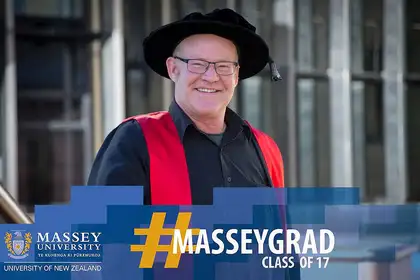
Dr Tim Barlow who has graduated with a PhD in Fine Arts.
Artist Tim Barlow has turned working with local communities to build a range of public fountains, festivals, pop-up venues and mobile community centres into original doctoral research.
Dr Barlow was conferred with his doctorate at Massey University’s Wellington graduation ceremonies at the Michael Fowler Centre. Between 2010 and 2015 he taught on staff at the University’s College of Creative Arts.
For the past four years he has joined community organisations from Taupō to Christchurch, collaborating on projects that held a particular relevance to the resources of the place and local people. There are differing opinions on the best way for socially-engaged art to empower local communities, he says.
His research was a concerted attempt as a graduate of the School of Art to step out from the studio space and actively engage with artists on the streets and in and around urban communities and bridge the perceived divide between studio art and community art.
“We should stop thinking in two camps as community engagement has the potential to create bridges between isolated communities and isolated artists.”
He cites a community project in Turangi that was part of his early doctoral research as an example of the way creativity encompasses both community and political objectives.
Coinciding with the Government sale of state assets like Mighty River Power, Dr Barlow built a fountain filled with geo-thermal water that the public were then invited to view on a platform. By jumping up and down on the platform, participants could build pressure so the fountain water erupted like a volcano.
Acknowledging, “talking about geo-thermal politics and the mining of geo-thermal water in New Zealand was controversial,” Dr Barlow said the fountain was a focal point for the political debate but was also a “fun” exhibit.
“One of the assumptions of community art is about its earnestness. What I’ve found working with communities is the need to have fun and provide some relief from the hard time many in the community are going through.”
In Lower Hutt he was responsible for reviving the infamous Elbe’s Milk Bar, a favourite haunt of teenagers in conformist 1950s New Zealand and the target of government scrutiny and a report at the time into moral delinquency.
Dr Barlow said the re-opened bar was staffed by youth he describes as “between schools” who were trained by some of those original 1950s teenagers and patrons accused by the Government of the time of lewd behaviour.
He saw parallels with the issues of those original teenagers such as identity, sexuality, money, family and bullying, and the youth who re-staffed the bar.
“It was a socially engaged artwork with young people talking about issues relevant to them,” he says.
His research also addressed concepts, packaged under the idea of social ethics in art, such as the idea of deceit with many works containing some form of illusion. At the same time he says they explored the depth of caring relationships. It is not just about an artist caring for a place, the people or a resource but also the way people engaging with the works show respect for the features of the art like in the Turangi exhibit-using geo-thermal water.
“It enables us to feel as well as view the art and think through some of these issues.”